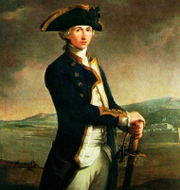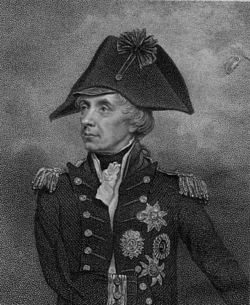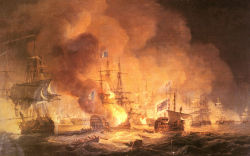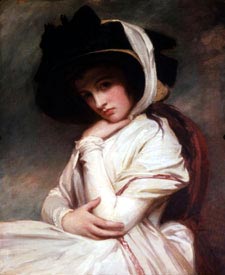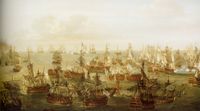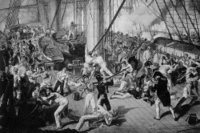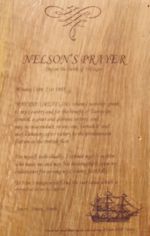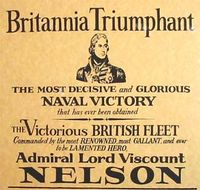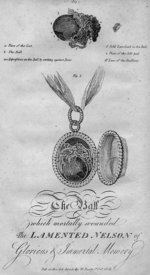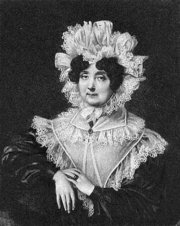Horatio Nelson, 1st Viscount Nelson
2007 Schools Wikipedia Selection. Related subjects: Military People
| Horatio Nelson, 1st Viscount Nelson | |
|---|---|
| September 28, 1758— October 21, 1805 | |
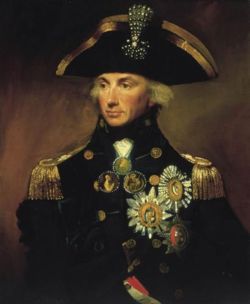 Horatio Nelson |
|
| Place of birth | Burnham Thorpe, Norfolk |
| Place of death | Cape Trafalgar, Spain |
| Allegiance | Kingdom of Great Britain Great Britain and Ireland |
| Rank | Vice Admiral |
| Battles/wars | Battle of Cape St Vincent Battle of the Nile Battle of Copenhagen Battle of Trafalgar |
| Awards | Several (see below) |
Vice-Admiral Horatio Nelson, 1st Viscount Nelson, KB ( 29 September 1758 – 21 October 1805) was an English admiral famous for his participation in the Napoleonic Wars, most notably in the Battle of Trafalgar, where he lost his life. It was as a result of these wars that he became the greatest naval hero in the history of the United Kingdom, eclipsing Admiral Robert Blake in fame. His biography by the poet Robert Southey appeared in 1813, while the wars were still being fought. His love affair with Emma, Lady Hamilton, the wife of the British Ambassador to Naples, is also well-known, and he is honoured by the London landmark, Nelson's Column, which stands in Trafalgar Square.
Biography
Early life
Horatio Nelson was born on 29 September 1758 in a rectory in Burnham Thorpe, Norfolk, the sixth of eleven children of The Revd Edmund Nelson and Catherine Nelson. His mother, who died when he was nine, was a grandniece of Sir Robert Walpole, 1st Earl of Orford, the de facto first prime minister of the British Parliament.
Nelson was briefly educated at Paston Grammar School, North Walsham, and Norwich School, and by the time he was twelve he had enrolled in the Royal Navy. His naval career began on 1 January 1771 when he reported to the third-rate Raisonnable as an ordinary seaman and coxswain. Nelson’s maternal uncle, Captain Maurice Suckling, commanded the vessel. Shortly after reporting aboard, Nelson was appointed a midshipman and began officer training. Ironically, Nelson found that he suffered from seasickness, a chronic complaint that dogged him for the rest of his life.
Suckling became Comptroller of the Navy in 1775 and used his position to help Nelson's rapid advance. By 1777 Nelson had risen to the rank of lieutenant and was assigned to the West Indies. During his service as lieutenant he saw action on the British side in the American Revolutionary War. By the time he was 20, in June 1779, he was made post. The 28-gun frigate Hinchinbroke, newly captured from the French, was his first command as post-captain.
In 1780 he was involved in an action against the Spanish fortress of San Juan in Nicaragua. Though the expedition was ultimately a major debacle, none of the blame was attributed to Nelson, who was praised for his efforts. He fell seriously ill, probably contracting malaria, and returned to England for more than a year to recover. He eventually returned to active duty and was assigned to Albemarle, in which he continued his efforts against the American rebels until the official end of the war in 1783.
Command
In 1784 Nelson was given command of the frigate Boreas, and assigned to enforce the Navigation Act in the vicinity of Antigua. This was during the denouement of the American Revolutionary War, and enforcement of the Act was problematic - now-foreign American vessels were no longer allowed to trade with British colonies in the Caribbean Sea, an unpopular rule with both the colonies and the Americans. After seizing four American vessels off Nevis, Nelson was sued by the captains of the ships for illegal seizure. As the merchants of Nevis supported them, Nelson was in peril of imprisonment and had to remain sequestered on Boreas for eight months. It took that long for the courts to deny the captains their claims, but in the interim Nelson met Fanny Nesbit, a widow native to Nevis. Nelson and Fanny were married on 11 March 1787 at the end of his tour of duty in the Caribbean.
Nelson lacked a command for a few years after 1789. He lived on half pay during this time (a reasonably common occurrence in the peacetime Royal Navy). Then, as the French Revolutionary government began aggressive moves beyond France's borders, Nelson was recalled to service. Given command of the 64-gun Agamemnon in 1793, he soon started a long series of battles and engagements that would seal his place in history.
He was first assigned to the Mediterranean, based out of the Kingdom of Naples. In 1794 he was wounded in the face by stones and debris thrown up by a close cannon shot during a joint operation at Calvi, Corsica. As a result, Nelson lost the sight in his right eye and half of his right eyebrow. Despite popular legend, there is no evidence that Nelson ever wore an eye patch, though he was known to wear an eyeshade to protect his remaining eye.
In 1796 the position of commander-in-chief of the fleet in the Mediterranean passed to Sir John Jervis, who appointed Nelson to be commodore and to exercise independent command over the ships blockading the French coast. Agamemnon, often described as Nelson's favourite ship, was by now worn out and was sent back to England for repairs. Nelson was appointed to the 74-gun HMS Captain.
Admiralty
1797 was a full year for Nelson. On 14 February he was largely responsible for the British victory at the Battle of Cape St. Vincent. Here he showed his flair for dramatic and bold action. Under the command of Sir John Jervis, the British fleet was ordered to "tack in line," but Nelson disobeyed these orders and gybed in order to prevent the Spanish fleet from escaping. He then boarded two enemy ships in succession, an unusual and bold move which was cheered by the whole fleet. Nelson himself led the boarding parties, which was not usually done by high ranking officers.
In the aftermath of this victory, Nelson was knighted as a member of the Order of the Bath (hence the postnominal initials "KB"). In April of the same year he was promoted to Rear Admiral of the Blue, the ninth highest rank in the Royal Navy. Promotion to admiral at this time was not based on merit but solely on seniority and the availability of positions to fill. Able captains such as Nelson were appointed commodore temporarily, a position which had the same pay and responsibilities as an admiral. Later in the year, while commanding Theseus during an unsuccessful expedition to conquer Santa Cruz de Tenerife, Nelson was shot in the right arm with a musketball, fracturing his humerus bone in multiple places. Since medical science of the day counselled amputation for almost all serious limb wounds (to prevent death by gangrene), Nelson lost almost his entire right arm and was unfit for duty until mid-December. He referred to the stub as "my fin."
This was not his only reverse. In December 1796, on leaving Elba for Gibraltar, Nelson transferred his flag to the frigate Minerve (of French construction, commanded by Captain Cockburn). A Spanish frigate, Santa Sabina, was captured during the passage and Lieutenant Hardy was put in charge of the captured vessel. The following morning, two Spanish ships of the line and one frigate appeared. Nelson decided to flee, leaving Santa Sabina to be recovered by the Spanish and Hardy was captured. The Spanish captain who was on board Minerve was later exchanged for Hardy in Gibraltar.
In 1798 Nelson was once again responsible for a great victory over the French. The Battle of the Nile (also known as the Battle of Aboukir Bay) took place on 1 August 1798. The battle effectively ended Napoleon's ambition to take the war to the British in India. The forces Napoleon had brought to Egypt were stranded. Napoleon attempted to march north along the Mediterranean coast but his army was defeated at the Siege of Acre by Captain Sir Sidney Smith. Napoleon then left his army and sailed back to France, evading detection by British ships. Given its huge strategic importance, some historians (see Vincent 2003) regard Nelson's achievement at the Nile as the most significant of his career, Trafalgar not withstanding.
For the spectacular victory of the Nile, Nelson was granted the title of Baron Nelson of the Nile. (Nelson felt cheated that he was not awarded a more prestigious title; Sir John Jervis had been made Earl of St. Vincent for his part in the battle of St. Vincent, but the British Government insisted that an officer who was not the commander-in-chief could not be raised to any peerage higher than a barony). Nelson felt throughout his life that his accomplishments were not fully rewarded by the British government, a fact he ascribed to his humble birth and lack of political connections as compared during his lifetime to Sir John Jervis, 1st Earl of St Vincent or after his death to the Duke of Wellington.
Not content to rest on his laurels, Nelson then rescued the Neapolitan royal family from a French invasion in December. During this time he fell in love with Emma Hamilton - the young wife of the elderly British ambassador to Naples. Emma became Nelson's mistress, returning to England to live openly with him, and eventually they had a daughter, Horatia.
In 1799 Nelson was promoted to Rear Admiral of the Red, the seventh highest rank in the Royal Navy. He was then assigned to the new second-rate Foudroyant. In July he aided Admiral Ushakov with the reconquest of Naples and was made Duke of Bronte by the Neapolitan king. Personal problems and some upper-level disappointment at his professional conduct caused him to be recalled to England, but public knowledge of his affair with Lady Hamilton eventually induced the Admiralty to send him back to sea, if only to get him away from her.
Some have suggested that a head wound Nelson received at Aboukir Bay was partially responsible for his personal conduct and for the way he managed the Neapolitan campaign. He was accused of allowing the monarchists to kill prisoners contrary to the laws of war. Perhaps Nelson's zeal was due simultaneously to his English hatred of Jacobins and his status as a Neapolitan royalist (as the Duke of Bronte). The Neapolitan campaign is now considered something of a disgrace to his name. On 1 January 1801 Nelson was promoted to Vice Admiral of the Blue (the sixth highest rank). Within a few months he took part in the Battle of Copenhagen ( 2 April 1801) which was fought in order to break up the armed neutrality of Denmark, Sweden, and Russia. During the action, his commander, Sir Hyde Parker, who believed that the Danish fire was too strong, signalled to Nelson to break off the action. Nelson ordered that the signal be acknowledged, but not repeated. He turned to his flag Captain, Foley, and said "You know, Foley, I only have one eye — I have the right to be blind sometimes," and then holding his telescope to his blind eye, said "I really do not see the signal!" His action was approved in retrospect and in May he became commander-in-chief in the Baltic Sea. He was awarded the title of Viscount Nelson by the British crown.
Meanwhile, Napoleon was massing forces to invade England. Nelson was placed in charge of defending the English Channel in order to thwart any such invasion. However, on 22 October 1801 an armistice was signed between the British and the French, and Nelson — in poor health again — retired to England where he stayed with his friends, Sir William and Lady Hamilton. The three embarked on a tour of England and Wales, culminating in a stay in Birmingham. They visited Matthew Boulton on his sick bed at Soho House and toured his Soho Manufactory.
The Battle of Trafalgar - death and burial
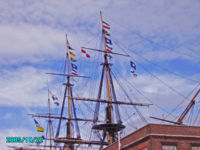
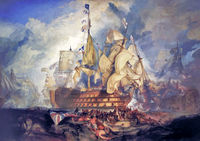
The Peace of Amiens was not to last long and Nelson soon returned to duty. He was appointed commander-in-chief in the Mediterranean. Assigned to HMS Victory in May 1803, Nelson joined the blockade of Toulon, France. He would not set foot on dry land again for more than two years.
Nelson was promoted to Vice Admiral of the White (the fifth highest rank) while still at sea, on 23 April 1804. The French fleet slipped out of Toulon in early 1805 and headed for the West Indies. (See battle of Cape Finisterre (1805) for a summary of this campaign.) A fierce chase failed to turn them up and Nelson's health forced him to retire to Merton in England.
Within two months Nelson returned to sea. On 13 September 1805 he was called upon to oppose the French and Spanish fleets which had managed to join up and take refuge in the harbour of Cádiz, Spain.
On 21 October 1805 Nelson engaged in his final battle, the Battle of Trafalgar. Napoleon Bonaparte had been massing forces once again for an invasion of the British Isles, but he decided that his navy was not adequate to secure the Channel for the invasion barges. Thus, Napoleon had started moving his troops for a campaign elsewhere in Europe. On 19 October the French and Spanish fleet set sail from Cádiz, probably because Pierre-Charles Villeneuve, the French commander, had learned that he was to be replaced. Nelson, with twenty-seven ships, engaged the thirty-three opposing ships.
Nelson's last dispatch, written on the 21 October, read:
At daylight saw the Enemy's Combined Fleet from East to E.S.E.; bore away; made the signal for Order of Sailing, and to Prepare for Battle; the Enemy with their heads to the Southward: at seven the Enemy wearing in succession. May the Great God, whom I worship, grant to my Country, and for the benefit of Europe in general, a great and glorious Victory; and may no misconduct in any one tarnish it; and may humanity after Victory be the predominant feature in the British Fleet. For myself, individually, I commit my life to Him who made me, and may his blessing light upon my endeavours for serving my Country faithfully. To Him I resign myself and the just cause which is entrusted to me to defend. Amen. Amen. Amen.
As the two fleets moved towards engagement, Nelson ran up a thirty-one flag signal to the rest of the fleet, spelling out the famous phrase "England expects that every man will do his duty". The original signal that Nelson wished to make to the fleet was Nelson confides that every man will do his duty (meaning 'is confident that they will'). The signal officer asked Nelson if he could substitute the word 'expects' for 'confides' as 'expects' was included in the code devised by Sir Home Popham, whereas 'confides' would have to be spelled out letter by letter. Another officer suggested that "England" would be more powerful than "Nelson." Nelson agreed, and the signal was run up Victory's mizzenmast.
After crippling the French flagship Bucentaure, Victory moved on to the Redoutable. The two ships became entangled, at which point snipers in the fighting tops of Redoutable were able to pour fire down onto the deck of Victory. Nelson was one of those hit: a bullet entered his shoulder, pierced his lung, and came to rest at the base of his spine. Nelson retained consciousness for four hours, but died soon after the battle ended with a British victory.(See Nelson's last words.) The bullet that ended Nelson's life was removed from his body and is now on public display in Windsor Castle.
Victory was towed after the battle to Gibraltar, with Nelson's body preserved in a barrel of brandy. Legend has it that, ironically, it was French brandy that had been captured during the battle. (See Tapping the Admiral). Upon the arrival of his body in London, Nelson was given a state funeral (one of only five non-royal Britons to receive the honour - others include the Duke of Wellington and Sir Winston Churchill) and entombment in St. Paul's Cathedral. He was laid to rest in a wooden coffin made from the mast of L'Orient which had been salvaged after the Battle of the Nile, within a sarcophagus originally carved for Cardinal Wolsey (when Wolsey fell from favour, it was confiscated by Henry VIII and was still in the royal collections in 1805).
Legacy
Nelson was noted for his considerable ability to inspire and bring out the best in his men, to the point that it gained a name: "The Nelson Touch". Famous even while alive, after his death he was lionised like almost no other military figure in British history (his only peers are the Duke of Marlborough and Nelson's contemporary, the Duke of Wellington). Most military historians believe Nelson's ability to inspire officers of the highest rank and seamen of the lowest was central to his many victories, as was his unequalled ability to both strategically plan his campaigns and tactically shift his forces in the midst of battle. Certainly, he ranks as one of the greatest field commanders in military history. Many consider him to have been the greatest warrior of the seas.
It must also be said that his "Nelson touch" also worked with non-seamen; he was beloved in England by virtually everyone. (The only people not affected by him were those offended by his affair with Lady Hamilton.) Now as then, he is a popular hero, included in the top 10 of the 100 Greatest Britons poll sponsored by the BBC and voted for by the public, and commemorated in the extensive Trafalgar 200 celebrations in 2005, including the International Fleet Review. Even today phrases such as " England expects" and "nelson" (meaning "111") remain closely associated with English sporting teams.
He is arguably the national hero of the United Kingdom.
Monuments to Nelson
The monumental Nelson's Column and the surrounding Trafalgar Square are notable locations in London to this day, and Nelson was buried in St. Paul's Cathedral. The first large monument to Nelson was a 43.5 m tall pillar on Glasgow Green erected less than year after his death in 1806. Nelson's Monument was later constructed atop Calton Hill in Edinburgh.
The first monument funded by popular subscription, sculpted by Richard Westmacott, was erected in Birmingham in 1809. The Statue of Horatio Nelson, Birmingham is Grade II* listed.
Westmacott also sculpted memorials in Liverpool and Barbados. A columnar Monument in Great Yarmouth to Nelson was started before his death but only completed in 1819. This is sometimes known as the " Britannia Monument" as it is topped by that martial female rather than a statue of Nelson; a statue of Nelson can however be found in the grounds of Norwich Cathedral alongside the other Napoleonic hero, the Duke of Wellington, near the school he attended.
There is also a memorial to Nelson on the banks of the Menai Straits in North Wales. This memorial stands at an out-of-the-way site on the shore below Plas Llanfair, in Llanfairpwll on the Anglesey shore. It was created by Admiral Lord Clarence Paget, who lived in the mansion and who was an enthusiastic amateur sculptor.
In Montreal (where Nelson had reportedly fallen in love with a young French-Canadian woman), there is a monument to Nelson (erected in 1809) in Place Jacques-Cartier, which was a marketplace at the time. It has carved scenes from Nelson's career around the base and the statue on top was claimed to be the oldest public statue of Nelson in the world. (It was removed for several years due to excessive weathering but has been replaced after restoration).
There is also the Nelson memorial in Swarland, Northumberland which was raised as a private memorial of Nelson by his friend and sometime agent, Alexander Davison. Nelson's Pillar, a monument to Nelson in Dublin was destroyed by a bomb planted by former IRA men in 1966. The city of Nelson, New Zealand bears his name as well as Nelson Island on the Sunshine Coast, British Columbia, Canada.
One of the most unusual monuments was constructed on Salisbury Plain, within cannon shot of Stonehenge, on land then owned by the Marquess of Queensbury. The monument consists of a series of clumps of trees in otherwise arable farmland. Known as the "Nile Clumps" they have been arranged to represent the positioning of French and British ships at the Battle of the Nile, considered as Nelson's greatest tactical victory. Some clumps still survive, and work is underway to replant some of those that have "sunk". They stand on land owned by the National Trust, forming part of the Stonehenge Historic Landscape estate.
Nelson and the Royal Navy
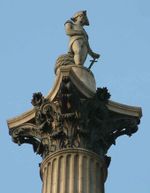
Victory is still kept on active commission in honour of Nelson — it is the flagship of the Second Sea Lord, and is the oldest commissioned Naval ship in the world. She can be found in Number 2 Dry Dock of the Royal Naval Museum at the Portsmouth Naval Base, in Portsmouth, England.
Three Royal Navy warships, and one shore establishment, have been named HMS Nelson in his honour. The Royal Navy celebrates Nelson every 21 October by holding Trafalgar Day dinners and toasting "The Immortal Memory" of Nelson.
The bullet that killed Nelson is permanently on display in the Grand Vestibule of Windsor Castle. The uniform that he wore during the battle, with the fatal bullet hole still visible, can be seen at the National Maritime Museum in Greenwich. A lock of Nelson's hair was given to the Imperial Japanese Navy from the Royal Navy after the Russo-Japanese War to commemorate the victory at the Battle of Tsushima. It is still on display at Kyouiku Sankoukan, a public museum maintained by the Japan Self-Defense Forces.
Nelson's descendants
Nelson had no legitimate children; his daughter, Horatia, by Lady Hamilton (who died in poverty when their daughter was 13), subsequently married the Rev. Philip Ward and died in 1881. She and Rev. Ward had nine children: Horatio Nelson (born 8 December 1822); Eleanor Philippa (born April 1824); Marmaduke Philip Smyth (born 27 May 1825); John James Stephen ( 13 February 1827– 1829); Nelson (born 8 May 1828); William George (born 8 April 1830); Edmund ( 10 July 1832– 1833); Horatio (born 24 November 1833), Philip (born May 1834) and Caroline (born January 1836).
Because Lord Nelson had no legitimate heirs, the Viscountcy and 1798 Barony of Nelson (both "of the Nile and of Burnham Thorpe in the County of Norfolk") became extinct upon his death. However, the 1801 Barony of Nelson ("of the Nile and of Hilborough in the County of Norfolk") passed by a special remainder to Lord Nelson's brother, The Reverend William Nelson. William was also created Earl Nelson in recognition of his brother's services, which title is still extant.
Literary influences
Although Nelson's exploits are often claimed to have provided inspiration for fictional characters such as Jack Aubrey and Horatio Hornblower, a close reading of the books does not bear this out. It is more likely Nelson's fame makes him the only naval figure of the time whom reviewers recall. Nelson appears, unnamed but recognizable, in Susan Sontag's novel The Volcano Lover: A Romance, which centers on Lady Hamilton's affair with him. Nelson himself appears as a ghost in Amber Benson's and Christopher Golden's Ghosts of Albion. Barry Unsworth's Losing Nelson centres on Nelson's actions in Naples in 1799.
Last words
Nelson's final words (as related by Victory's Surgeon William Beatty, based on the accounts of those who were with Nelson when he died) were "Thank God I have done my duty." According to Beatty, he repeated these words several times until he became unable to speak. It is still unknown whether he was in a delirious state when repeating the sentence.
In his dying hours, Nelson was also attended by his chaplain, Alexander Scott; his steward, Chevalier; and the purser, Walter Burke. Their accounts have been available to Nelson's modern biographers. In those accounts, Nelson's last words were "Drink, drink. Fan, fan. Rub, rub." This was a request to alleviate his symptoms of thirst, heat, and the pains of his wounds. (Pocock, Horatio Nelson, 1987, p.331.)
It is a common misconception that Nelson's last words were, "Kiss me, Hardy", spoken to the captain of HMS Victory, Thomas Hardy. Nelson did, in fact, say these words to Hardy a short time before his death, but they were not his last words as Hardy was not present at his death, having been called back on deck. Some have speculated that Nelson actually said "Kismet, Hardy", but this is impossible, since the word kismet did not enter the English language until much later, although he may have heard the word used by a Turk.
Titles
Nelson's titles, as inscribed on his coffin, were The Most Noble Lord Horatio Nelson, Viscount and Baron Nelson, of the Nile and of Burnham Thorpe in the County of Norfolk, Baron Nelson of the Nile and of Hillborough in the said County, Knight of the Most Honourable Order of the Bath, Vice Admiral of the White Squadron of the Fleet, Commander in Chief of his Majesty's Ships and Vessels in the Mediterranean, Duke of Bronte in Sicily, Knight Grand Cross of the Sicilian Order of St Ferdinand and of Merit, Member of the Ottoman Order of the Crescent, Knight Grand Commander of the Order of St. Joachim.
He was a Colonel of the Marines. He was voted a Freeman of Bath, Salisbury, Exeter, Plymouth, Monmouth, Sandwich, Oxford, Hereford, and Worcester.
The University of Oxford, in full Congregation, bestowed the honorary degree of Doctor of Civil Law upon Nelson in 1802.
Nelson was created Duke of Bronte by the King of Naples in July 1799.
